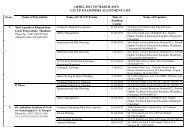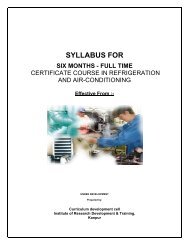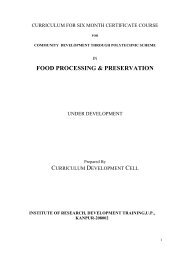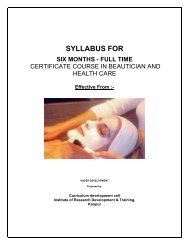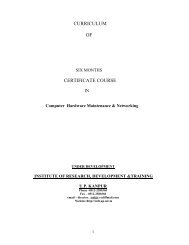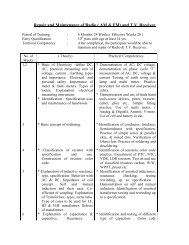Computer Application - Home - NIC
Computer Application - Home - NIC
Computer Application - Home - NIC
You also want an ePaper? Increase the reach of your titles
YUMPU automatically turns print PDFs into web optimized ePapers that Google loves.
CURRICULUM<br />
OF<br />
SIX MONTHS<br />
CERTIFICATE COURSE<br />
IN<br />
COMPUTER APPLICATION<br />
UNDER DEVELOPMENT<br />
INSTITUTE OF RESEARCH, DEVELOPMENT &TRAINING<br />
U.P. KANPUR<br />
Phone -0512-2580360<br />
Fax – 0512-2580360<br />
email – director_ irdt@ rediffmail.com<br />
Website:http://irdt.up.nic.in
Main Features of Curriculum<br />
1. Title of the course : <strong>Computer</strong> <strong>Application</strong><br />
2. Duration of Course : Six Months<br />
3. Type of the course : Full time<br />
4. Admission Qualification : Knowledge of English<br />
CURRICULUM<br />
SIX MONTHS<br />
CERTIFICATE COURSE<br />
OF<br />
COMPUTER APPLICATION<br />
Module I 2 Weeks<br />
1.History of <strong>Computer</strong> & Fundamentals<br />
2.Hardware & Software Concepts<br />
3.Concept of Operating System<br />
Module II 6 Weeks<br />
1.Office Automation& Programming Practice<br />
2.Concept of Internet & Communication<br />
Module III 12 Weeks<br />
1.Tally 9.0<br />
2. D.T.P<br />
3.WEB Designing
STUDY & EVALUATION SCHEME<br />
FOR<br />
CERTIFICATE COURSE<br />
<strong>Computer</strong> <strong>Application</strong><br />
. (Effective from …………….)<br />
S.No<br />
1.<br />
2.<br />
3.<br />
1.<br />
2.<br />
SUBJECT<br />
MODULE I<br />
2 WEEKS<br />
HISTORY OF<br />
COMPUTER &<br />
FUNDAMENTALS<br />
HARDWARE &<br />
SOFTWARE<br />
CONCEPTS<br />
CONCEPT OF<br />
OPERATING<br />
SYSTEM<br />
MODULE II<br />
6 WEEKS<br />
OFFICE<br />
AUTOMATION&<br />
PROGRAMMING<br />
PRACTICE<br />
CONCEPT OF<br />
INTERNET &<br />
COMMU<strong>NIC</strong>ATION<br />
MODULE<br />
III<br />
PERIOD<br />
PER DAY<br />
THEORY<br />
PRAC<br />
EXAM<br />
SCHEME<br />
PRAC<br />
EXAM<br />
DUR<br />
01 - - -<br />
01 01 01 25<br />
01 02 03 50<br />
01 02 03 50<br />
01 02 03 50<br />
TOTAL<br />
MARKS<br />
1.<br />
12 WEEKS<br />
TALLY 9.0 01 01 03 50<br />
2. D.T.P<br />
01 01 03 50<br />
3. WEB DESIGNING 01 01 03 50<br />
TOTAL<br />
20 WEEKS<br />
325<br />
NOTE: (1) Each period will be of 50 minutes duration.<br />
(2) Each session will be of 24 weeks.<br />
(3) Effective teaching will be atleast 20 weeks.<br />
(4) Remaining periods will be utilised for revision etc.<br />
(5) Emphasis should be on Practical Aspect.<br />
(6) Sufficient practice session of English & Hindi typing should be provided in<br />
Module I & Module II.
Module I<br />
Unit –I History of <strong>Computer</strong> & Fundamental<br />
1. History of <strong>Computer</strong>.<br />
• Abacus of NIAC, <strong>Computer</strong> Generation, Languages, Software and<br />
applications. <strong>Computer</strong> in India.<br />
•<br />
2. <strong>Computer</strong> an Introduction.<br />
* Function of computer: Input, processing and output, function of<br />
ALU, control, storage input and output devices.<br />
• <strong>Application</strong> of <strong>Computer</strong>: viz. Railway reservation, electronics/<br />
telephone etc.<br />
3. Types of computers & classification.<br />
• Classification of computer : Analog , Digital and Hybrid, Types of<br />
computer: <strong>Home</strong>, micro, mini, main from, super and laptop ,<br />
pocket computers.<br />
• Centralized decentralized distributed systems.<br />
4. Characteristics of computer.<br />
• The character: High speed, Accuracy, Storage, Automation,<br />
Diligence, Versatility, Cost effective, No feeling.<br />
5. Number System & Function.<br />
• Binary, binary addition and subtraction, decimal, octal,<br />
hexadecimal, Bit, byte, characters, field, record and fill.<br />
• BCD, EBCDIC, ASCH Bit, byte, characters, field, record and fill<br />
etc.<br />
Unit- II Hardware and Software Concepts.<br />
1. Input Devices.<br />
• Input device: On line data input device and their importance, dumb<br />
terminal , intelligent terminal, voice recognition. Touch tone<br />
terminal , mouse.<br />
• Off Line data input: Key to disk system. Key to tape system, Key<br />
to punched card.<br />
• Source data input: point to scale terminal , Leaser beam scanners.<br />
Optical mark readers ( OMR), optical character ( OCR) and<br />
magnetic ink character readers ( MICR)
2. Output Devices.<br />
• Hard copy device : Dot matrix printers, Ink jet printers, laser<br />
printers, plotter output.<br />
• Soft copy devices: VDU ( Monochrome & colors) , LCD ( liquid<br />
crystal display), audio response unit, micro film.<br />
3. CPU Architecture & Block diagram of computer.<br />
• CPU architecture & ALU : Instruction , fetch and execution cycles,<br />
control unit micro- programming concept, speed mismatch<br />
between CPU and memory.<br />
4. Memory Devices.<br />
• Memory devices: RAM, ROM, PROM, EPROM, EEPROM,<br />
ECCRAM, EDO RAM, and their specification. Memory, storage<br />
locations, use of memory addressing in programming.<br />
• Secondary memory devices: floppy disk, hard disk<br />
( removable/fixed), concept of cylinders, tracks and sectors,<br />
advantage and limitations of secondary storage, access time, access<br />
methods ( Sequential, Direct).<br />
5. Introduction of Software.<br />
• Software concepts: application & systems software, Assembler,<br />
compiler, interpreter, multi user, multi tasking, multi programming<br />
operating system.<br />
• Virus protection diagnostic tools.<br />
Unit- III Concept of Operating System.<br />
1. Introduction & Configurations.<br />
• Definition & Evolution of Operating System : Serial Processing,<br />
Batch Processing Multi Programming.<br />
• Main Function of operating: Process Management, Memory<br />
Management, File Management. Security management and<br />
command interpreting.<br />
2. Types of operating systems & classification<br />
• Types of operating system: User based & GUI based, Single user,<br />
multi user, Batch operating systems, Multi programming operating<br />
systems, Network operating systems and Distributed operating<br />
system.
3. Features of Window XP.<br />
• Definition & Features of windows XP: component of the desktop:<br />
Icons, Taskbar, Background, Screen Saver, Logging on & Turn<br />
off windows xp, part of windows.<br />
• Arrange the icons on the desktop, Move, minimize, maximize,<br />
resize and close a window, using menu bars and toolbars.<br />
4. Configuration of Windows XP environmental<br />
• Identify the purpose of the start menu: Add a printer and add or<br />
remove programs. Help and support, search, Run, Control panel.<br />
• The start menu command: my computer, my document, my resent<br />
document , my picture, my music, game, my network place,<br />
Internet explorer, E- mail.<br />
5. First Aid maintenance.<br />
• Measuring, Main supply, earth voltage & checking ear thing.<br />
• Precautionary measures in handling/ operating: VCD, CD, HDD,<br />
FDD, DVD, Scanner, Modem, Keyboard, Mouse, Hub, Monitor,<br />
UPS, CVT.<br />
• Printers: Dot Matrix, Inkjet, Laser- Feeding paper, Installing the<br />
cartridge, refilling the cartridge.<br />
6. Basic DOS commands.<br />
• Introduction of DOS ( Disk operating systems) – Files, Directories,<br />
Sub directory, Root directory, Current Directory, Drives, Using<br />
extensions, File and Directory naming conventions.<br />
• DOS command : External command, Internal command.
MODULE II<br />
Unit – I Office Automation Package<br />
1. Introduction of MS office<br />
• Definition & Features of the MS office: Microsoft 2003 & 2007<br />
word. MS Word, MS excel, MS power point, MS access and MS<br />
outlook.<br />
• Working with note pad, word pad and paint.<br />
2. Basics of Word Processing.<br />
• Creating a simple document in word : opening document and<br />
creating documents, Saving & quite document, text selection,<br />
editing document.<br />
• Using interface: Menus, Toolbars, printing , typing and revising<br />
text.<br />
• Formatting paragraph: Creating right and left alignment , tab stops,<br />
line spacing , paragraph, spacing , borders and shading.<br />
• Document template, page setup, table and sorting & numbering<br />
cells, special tasks with tables.<br />
• Mail merge: Data sources 7 main document , starting & editing the<br />
main document merge printing envelopes & labels.<br />
3. Spreadsheet Package .<br />
• Working with worksheet: Data entry in cells, Entry in numbers,<br />
text and formula, moving data in a work sheet, selecting data<br />
range, saving and quitting, cell reference.<br />
• Formatting and calculation: Calculation and auto fill, efficient data<br />
display with data formatting, number formatting, working with<br />
ranges, working with printing.<br />
• Working with graphics and charts: Adding/ Formatting text data<br />
with auto format, creating embedded chart using chart wizard,<br />
changing chart wizard, adding title, legend and gridline.<br />
• Database management: finding records with data form, adding/<br />
deleting records, filtering records in a work sheet.<br />
4. Graphic and Presentation package<br />
• Introduction of Graphics : Presentation, Analytical, Design<br />
• The power interface: Title bar, menu bar, toolbars, status bar, task<br />
pane.<br />
• Component of presentation: Slides, Outline, speaker notes,<br />
handout.<br />
• Crate a new presentation: save a presentation, navigate and edit<br />
slides, apply design templates to slides, apply the background<br />
colors to slides, open and exiting presentation.
• View a presentation in different mode: Inset pictures into<br />
presentation, Insert word art and auto shapes, add animation effects<br />
to slides, apply transition effects to slides, Running a slide show.<br />
5. Programming practice and Technique.<br />
• Data capture and validation , Data entry package , input from<br />
design, data editing, key to disk systems, validation & control.<br />
• Laboratory exercises on data entry, tele typewriter , video display<br />
terminal dot matrix printer.<br />
• Exercise on data collection, data validation and data verification<br />
• Exercise on transferring data from one medium to another/<br />
including back up restore.<br />
Unit –II Concept of Internet & Communication<br />
1. Introduction of Internet.<br />
• History of Internet, Internet connection setup & sharing, web with<br />
internet explorer, internet explorer file management , web address,<br />
search methods.<br />
2. Concept of Networking.<br />
• Concept of Networking: LAN, WAN, MAN, Data communication,<br />
component of communication, Data representation.<br />
3. Protocols and Standard<br />
• Definition of protocols & stander: TCP/IP, FTP, ISP, NSP,<br />
standard creation committees.<br />
4. e-Mail Accounts<br />
• Introduction of e-Mail, understand and describe e-mail, sing up for<br />
a mail account, read, send, delete e-mail massage in the Inbox.<br />
5. Web Page with Front page<br />
• Create a web page, add to text a web page. Modify text in a web<br />
page. Insert graphics into web page, save and preview a web page,<br />
publish a site on the web.<br />
• The terms of Internet: WWW, Web, Web site, Web page,<br />
Hyperlink, Windows, Toolbar, Menu Bar.
MODULE III<br />
Unit -1<br />
Tally 9.0<br />
1.Basics of Accounting,<br />
•Tally Fundamentals (Learning how to use of Tally)<br />
•Processing Transactions in Tally.<br />
2.Accounting on <strong>Computer</strong>s<br />
•Report Generation (Creating statements like Invoice, Bill, Profit & Loss account etc.).<br />
3.Features of Tally (Company creation etc.)<br />
•Business Organizations (Different areas like Schools, Colleges, Shops, Factory etc)<br />
•Double entry system of bookkeeping<br />
•Recording Transactions.<br />
4.Budgeting Systems,<br />
•Scenario management and Variance Analysis, Use Tally for Costing, Ratio Analysis.<br />
5.Costing Systems<br />
•Understanding Ratios,Analysis of financial statements Cash Flow Statement and<br />
•Funds Flow Statement Analyzing and Managing Inventory.<br />
6.Inventory Basics,<br />
•POS Invoicing, TDS, TCS, FBT, VAT & Service Tax Processing in Tally.<br />
•Interface in Different Languages,Processing Payroll Functions in Tally<br />
•Administration and Other Utilities<br />
Unit -2<br />
Desk Top Publishing<br />
PageMaker<br />
• Working with tool bar, Setting defaults, Opening, saving and closing publications.<br />
• Inserting and removing pages. Flowing text, resizing the object, Adjusting graphics or<br />
text objects<br />
• Select multiple elements. Selecting elements behind the others.<br />
• Mask and group, unmask and ungroup.
• Constrain move vertically/horizontally. Paste items, editing objects, rotating text box.<br />
• Layout window, viewing pages, changing previous and next pages, zooming and<br />
hyperlinks Font style, size, case. Subscript and superscript.Inserting Special characters,<br />
bullets, page numbering .Spacing of character, line, word and paragraph.<br />
• Breaking and non breaking.Text editing – selecting word, paragraph and a range of text.<br />
• Indenting/Tabs, Find and change dialogue box, Text recomposition<br />
• Compress paint, JPG and GIF files, Using Palletes control, colour palletes, styles palet<br />
and master pages pallet.Removing master page objects from pages,control pallets.<br />
• Making tables, editing data in tables.<br />
• Filing, stroking, frames, arranging, text<br />
• Wrapping, grouping and ungrouping, locking and unlocking, mask/unmask image,<br />
polygon. setting, rounded corners.<br />
CorelDraw<br />
• Use of various tools such as Pick tools,Zoom tools, Free hand tool, square tool,<br />
rectangle tool, Text tool, Fill tool etc. and allfonts used in designing of monograms,<br />
logos,posters, stickers, greeting cards, wedding cards, visiting cards, etc.<br />
Photo Shop<br />
Photo editing /inserting starting with<br />
• Setting Up<br />
• The Interface<br />
• Managing Palettes<br />
• Working With Photoshop Tools<br />
• Working With Layers<br />
Unit -3<br />
Web designing<br />
1. Introduction to Web<br />
• Connecting to Internet.Browsing popular sites and using search engines.<br />
2.Introduction to HTML<br />
• HTML features and uses, structure of an HTMLdocument,<br />
• Using HTML editor, creating simpleHTML documents, containing heading,body text<br />
and comments<br />
• Creating web pages with all thefeatures and effects.<br />
• Converting MS Office documents toHTML.<br />
• Creation of web pages containing tables of different formats.<br />
• Practice on modification of tables.Creating Lists using Bullets and Numbers.<br />
• Using HTML for creating web pages with links to other pages different points of a page<br />
and link to tables and list.<br />
• Creating web pages containing images,
3.Multimedia Objects:<br />
• Animation graphics using GIF animator or some other software.<br />
• Inserting Images, Video & Soundeffects. Marquees of Scrolling text.<br />
4.Frames –<br />
• Setting and releasing frames. Using one frame to index another. Creating floating<br />
frames, borderless frames and frames with borders.<br />
5.Forms –<br />
• Creating basic forms.<br />
• Using HTML to design different types of forms, incorporating different type of<br />
boxes, buttons, menus and fields. Adding text box, check box,radio buttons, pull-down<br />
menus, single-line text fieldand password field.. Processing the form.<br />
6.Style sheets –<br />
• Creating style sheets to other HTML element, altering different characteristics and<br />
features.Cascading HTML style sheets.<br />
7. DHTML –<br />
• Creating layers using style sheet syntax. Create animation.<br />
• Designing web pages with taught elements along with style elements for different<br />
characteristics.<br />
• Practice cascading style sheets.<br />
• Creating animation in the web pages using layers.<br />
• Using Apache Software<br />
• Links - Creating links to local range, other pages,<br />
specific part of page, electronic mail.
Tools & Equipment:<br />
• Hardware:<br />
•. Server <strong>Computer</strong> (Latest configuration)<br />
•. Multimedia Nodes (Pre-loaded Windows 2000 or latest)<br />
•Inkjet/Laser Printer<br />
•. UPS<br />
• Software:<br />
• Windows 2000<br />
• Microsoft Office 2003 Professional or latest<br />
• Anti Virus Software (TVD/ Norton/Any popular brand)<br />
• 1 Windows 2000 Server / Linux Server or latest<br />
• Tally 9 Single / Multi User Package or latest<br />
• PageMaker Latest Version<br />
• Adobe Photoshop latest version<br />
• Corel Draw<br />
• Netscape Navigator 4.0 or latest<br />
• GIF Animator & Editor<br />
• Adobe Photoshop<br />
• HTML Editor<br />
• Internet Connection<br />
Kindly mail your suggestions/feedback for improvement/development of<br />
the curriculum to:-<br />
R.P.Alam<br />
Asst Professor<br />
Institute of Research ,Development & Training,U.P.<br />
Kanpur-208002<br />
E mail:- director_irdt@rediffmail.com



